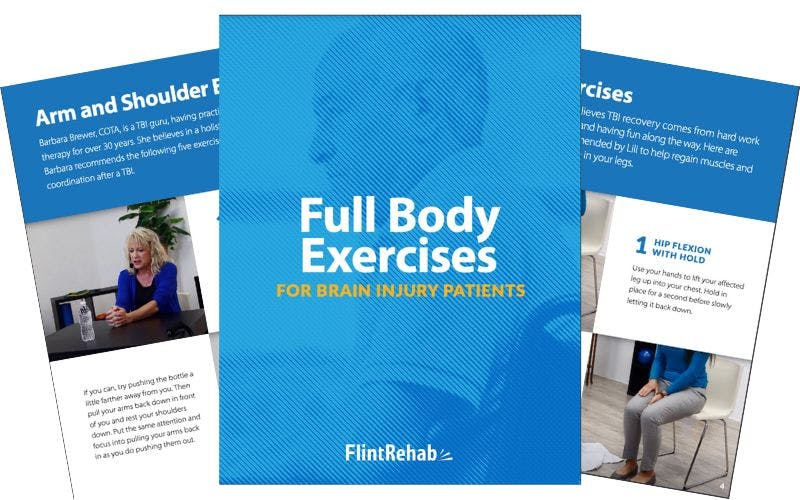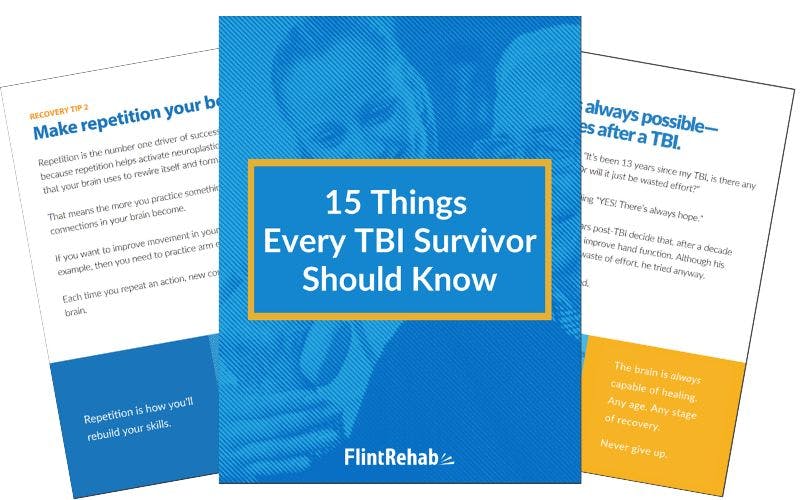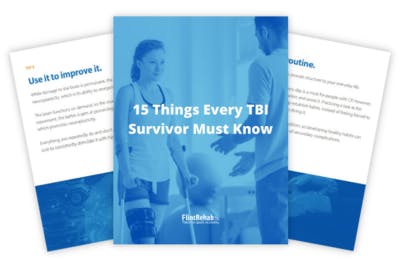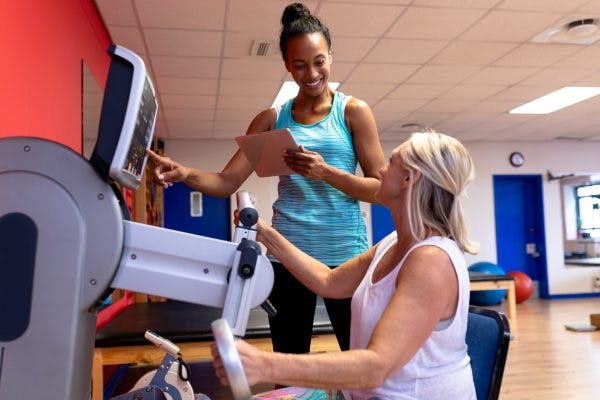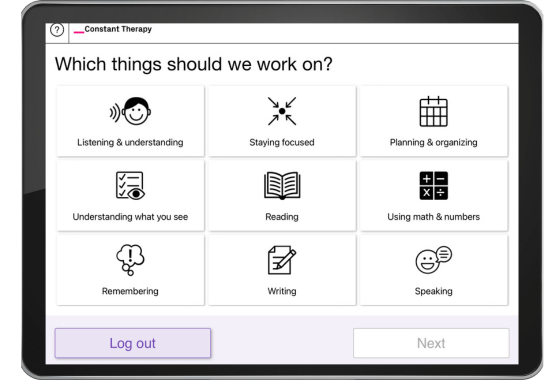Every brain injury is different and therefore every survivor’s recovery process looks different. However, while each brain injury is unique there are many TBI recovery tips that can help during the rehabilitation process no matter what stage of recovery you’re in.
Healing the mind is just as important as healing the body. This article will discuss some of the most effective TBI recovery tips to help boost both your physical and mental health.
Let’s dive right into it.
TBI Recovery Tips to Help Restore Physical Ability
After a brain injury, many survivors experience physical complications such as increased spasticity or even paralysis. Fortunately, there are ways to overcome many of the physical challenges of TBI recovery.
Here are some helpful TBI recovery tips that can help during rehabilitation:
1. Activate neuroplasticity to help the brain heal
When the brain sustains damage after an injury, the signals it sends throughout the body can become interrupted, resulting in specific secondary effects, such as loss of movement or sensation.
Fortunately, the brain has the ability to rewire itself through neuroplasticity. During this process, new neural pathways are created and existing pathways are strengthened, allowing the brain to have better communication and restore function after TBI.
It’s important for brain injury survivors to activate neuroplasticity as much as possible, making it one of the most important TBI recovery tips. But this begs the question: how?
2. Encourage repetition to maximize recovery
One of the best ways to activate neuroplasticity is by encouraging repetition or massed practice. The more you practice an exercise or skill, the more your brain will recognize its importance and create/strengthen neural pathways for that skill.
For example, to improve arm movement after TBI, it’s important to practice arm exercises with high repetition. This helps stimulate the brain and strengthen the skill of arm function.
Like repetition, massed practice can help you regain function and return to your daily activities.
3. Push through plateaus even if progress slows
The brain enters what is known as a “heightened state” of plasticity after a brain injury. In this state, you may see progress rather quickly. However, after about 3-6 months, this heightened state decreases and causes survivors to believe that progress has also slowed.
Therapists refer to these stalls in recovery as plateaus, which are common in the rehabilitation process. They are to be expected and should not discourage you from pursuing more recovery.
It’s important to continue rehabilitation exercises at home to keep the brain stimulated and encourage recovery well past the plateau stage.
4. Maintain a nutritious, brain-boosting diet

After TBI, the brain usually requires more energy to heal and sustain itself which is why it’s important to maintain a healthy diet. Helpful foods for brain injury encourage fuel recovery.
Also, a nutritious diet can also help improve cognitive function and reduce stress and anxiety, which are secondary effects that some survivors may experience.
Excellent foods for TBI recovery include fish, walnuts, eggs, vitamin B12, and dark, leafy greens. Some supplements may also be useful, but be sure to consult with your doctor before adding anything new to your diet.
5. Get to the root of spasticity
Survivors may also experience spasticity after TBI, which is an uncontrollable stiffening of the affected muscles. This is caused by a disruption of signals between the brain and body as a result of the injury.
It helps to understand that spasticity is not a direct issue with your muscles, but rather the brain’s miscommunication. Engaging in activities that promote neuroplasticity can help reduce muscle stiffness and restore mobility in the long-run.
6. Avoid regression
Additionally, when you don’t exercise your affected limbs, you don’t activate neuroplasticity and, furthermore, potentially risk losing function altogether. This is where the phrase “use it or lose it” comes from.
To prevent this from happening, be sure to engage in consistent and repetitive rehabilitation exercises to retain function and improve it.
7. Keep making progress by continuing therapy at home
Attending physical and/or occupational therapy is crucial. However, once insurance stops covering appointments, it can become too expensive to be sustainable, which may interfere with your recovery. This is why it’s important to practice therapy at home.
FitMi is a gamified neurorehabilitation device clinically proven to help survivors improve full-body function. It adjusts to your ability level and provides exercises you can practice at home as much as you’d like.
8. Get enough sleep to help improve brain function

Studies have shown that sleep is essential in helping restore body and brain functions after brain injury. Sleep helps improve memory, learning, and many other cognitive functions that survivors may struggle with after injury.
However, it can be difficult for survivors to sleep after TBI, but there are ways to help ease your mind and promote a good night’s rest. For instance, creating healthy habits and adjusting your lifestyle can help improve your sleep significantly. Some examples of healthy habits include, waking up and going to bed at the same time, paying attention to excessive napping, and limiting excessive screen use.
There are also natural remedies that can help with sleep such as tea or acupuncture. When that’s not enough to help, you can also talk to your doctor about medication.
9. Learn about foot drop and why it occurs
After a TBI, survivors may experience foot drop, which involves difficulty with dorsiflexion (the ability to lift the foot back towards the shin). This is usually caused by damage to the areas of the brain that are responsible for dorsiflexion.
There are multiple ways to treat foot drop including passive exercise, functional electrical stimulation, or medication. Speak with your therapist to find the most effective treatment.
10. Ask your neurologist about the areas of the brain impacted by injury
Different areas of the brain are responsible for different functions. Therefore, it helps to understand which areas of the brain were impacted by TBI, because it can help provide clues about what secondary effects may occur.
You can ask your neurologist for this information. You can also ask if the injury was mild or severe, and which hemisphere was impacted (the right or left). All of these questions help provide extra insight on the road to recovery.
Learn more about the different types of brain injury »
Motivating TBI Recovery Tips for the Road to Recovery
After TBI, survivors may also struggle maintaining a positive, healthy mindset due to secondary effects like anxiety and mental fatigue. Therefore, healing the mind is just as critical as healing the body.
Here are a few TBI recovery tips that can help heal the mind and promote a higher recovery:
11. Find clarity by setting attainable recovery goals
It helps to set long-term and short-term goals to help create motivation and structure on the road to recovery. One goal-setting method you can use is the SMART approach: specific, measurable, achievable, relevant, and time-bound. You can keep track of these in a recovery journal where you can also track your progress.
12. Pursue a full recovery
Many may wonder if there is a time limit for making a full TBI recovery, and the answer is no. Every brain injury is different and so is the rehabilitation process. Some survivors improve and restore function early on in their recovery, while others do so months, even years after brain injury. If you aren’t seeing the progress you’d like early on in your recovery, don’t give up. Use these TBI recovery tips to help kickstart your progress.
You can also get inspired by reading some inspiring brain injury recovery stories.
13. Use mental imagery to promote neuroplasticity

The mind is a powerful tool that can help improve function after brain injury. Even if your physical abilities are not yet where you want them to be, you can use mental imagery to promote recovery.
Mental imagery works by visualizing the function(s) you want to restore. For example, if you want to get better at walking, you can mentally practice walking by visualizing it. This helps activate neuroplasticity, and the more you visualize it, the more the brain will recognize it.
14. Meditate to help grow your brain
Survivors may experience stress and anxiety after traumatic brain injury, therefore finding relaxation techniques is important. Stress in particular can interfere with memory and attention, which are common cognitive effects of TBI.
Fortunately, studies have shown that meditation helps reduce stress and grow the areas of the brain responsible for memory and attention. This makes meditation an even more attractive technique for survivors.
15. Motivate yourself with accountability
If you ever find your motivation running low, it can help to find external motivation. For example, if you struggle with making it to your therapy appointments on-time, ask a friend to drive you. That way, you have external accountability. If you struggle with adynamia, or low motivation after brain injury, this is even more important.
Maximize Your Independence with These TBI Recovery Tips
It’s important to remember that the mind and body are both healing during the rehabilitation process and require lots of time and patience. Every brain injury is different and therefore the road to recovery is different for every survivor. With these 15 TBI recovery tips you’ll be well on your way to restoring function and increasing independence. Keep on going!


